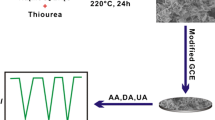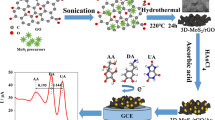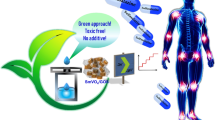Abstract
This study is the first report on the application of Co9S8@MoS2 core–shell nanoparticles decorated with reduced graphene oxide in the fabrication of an electrochemical sensor. This sensor exhibited great performance in the determination of metronidazole in blood plasma and tablet samples. These nanoparticles were synthesized via a facile and simple preparation method. First, Graphene oxide was synthesized via the Hummer method, and then Co9S8@MoS2 core–shell nanoparticles were synthesized on the surface and edges of the reduced graphene oxide. In this way, the glassy carbon electrode was modified with Co9S8@MoS2/Reduced graphene oxide nanoparticles. The nanocomposites were characterized by X-ray diffraction, transmission electron microscopy, scanning electron microscopy, energy dispersive X-ray, and Fourier transform infrared spectroscopy. The performance of the prepared sensor was studied by hydrodynamic amperometry and cyclic voltammetry techniques. A significant rise in the peak current and a considerable reduction in the overpotential of metronidazole were identified in the prepared sensor compared to the bare glassy carbon electrode. Under optimized conditions, two linear ranges of 0.5–35.0 μM and 35–180 μM and a limit of detection of 0.38 µM were obtained for metronidazole through the hydrodynamic amperometry technique using the proposed sensor. The Co9S8@MoS2/Reduced graphene oxide sensor demonstrated good reproducibility, fast response, and a large specific area.
Graphical Abstract













Similar content being viewed by others
Data availability
The datasets generated during the current study are available from the corresponding author on reasonable request.
References
Rajaji U, Govindasamy M, Sha R, Alshgari RA, Juang RS, Liu TY (2022) Surface engineering of 3D spinel Zn3V2O8 wrapped on sulfur doped graphitic nitride composites: investigation on the dual role of electrocatalyst for simultaneous detection of antibiotic drugs in biological fluids. Compos B Eng 242:110017
Govindasamy M, Wang SF, Almahri A, Rajaji U (2021) Effects of sonochemical approach and induced contraction of core–shell bismuth sulfide/graphitic carbon nitride as an efficient electrode materials for electrocatalytic detection of antibiotic drug in foodstuffs. Ultrason Sonochem 72:105445
Rajaji U, Chen TW, Chinnapaiyan S, Chen SM, Govindasamy M (2020) Two-dimensional binary nanosheets (Bi2Te3@ g-C3N4): application toward the electrochemical detection of food toxic chemical. Anal Chim Acta 1125:220–230
Hasan SH, Abdullah NS (2018) Spectrophotometric methods for determination of metronidazole in pharmaceutical formulations. Zanco J Pure Appl Sci 30(5):89–100
Ho C, Sin DW, Wong K, Tang HP (2005) Determination of dimetridazole and metronidazole in poultry and porcine tissues by gas chromatography–electron capture negative ionization mass spectrometry. Anal Chim Acta 530(1):23–31
Wang Y, Yao L, Liu X, Cheng J, Liu W, Liu T et al (2019) CuCo2O4/N-doped CNTs loaded with molecularly imprinted polymer for electrochemical sensor: preparation, characterization and detection of metronidazole. Biosensors Bioelectron 142:111483
Kalaiyarasi J, Pandian K (2019) Egg-shell like hollow alumina sphere modified electrode for enhanced electrochemical determination of metronidazole. J Electrochem Soc 166(13):B1151
Akay C, Özkan SA, Şentürk Z, Cevheroğlu Ş (2002) Simultaneous determination of metronidazole and miconazole in pharmaceutical dosage forms by RP-HPLC. Il Farmaco 57(11):953–957
Gadallah MI, Ali HRH, Askal HF, Saleh GA (2019) Innovative HPTLC-densitometric method for therapeutic monitoring of meropenem and metronidazole in acute pancreatic patients. Microchem J 146:940–947
Xia KD, Lu CX, Yang Y (2015) Improving the oxidation resistance of carbon fibers using silicon oxycarbide coatings. New Carbon Mater 30(3):236–243
Nagaraja P, Sunitha K, Vasantha R, Yathirajan H (2002) Spectrophotometric determination of metronidazole and tinidazole in pharmaceutical preparations. J Pharm Biomed Anal 28(3–4):527–535
Yang G, Zhao F, Zeng B (2014) Magnetic entrapment for fast and sensitive determination of metronidazole with a novel magnet-controlled glassy carbon electrode. Electrochim Acta 135:154–160
Kokulnathan T, Chen SM (2019) Praseodymium vanadate-decorated sulfur-doped carbon nitride hybrid nanocomposite: the role of a synergistic electrocatalyst for the detection of metronidazole. ACS Appl Mater Interfaces 11(8):7893–7905
Ranganathan P, Mutharani B, Chen SM, Sireesha P (2019) Biocompatible chitosan-pectin polyelectrolyte complex for simultaneous electrochemical determination of metronidazole and metribuzin. Carbohyd Polym 214:317–327
Zhu M, Ye H, Lai M, Ye J, Kuang J, Chen Y et al (2018) Differential pulse stripping voltammetric determination of metronidazole with graphene-sodium dodecyl sulfate modified carbon paste electrode. Int J Electrochem Sci 13(4100):73
Yuan S, Bo X, Guo L (2019) In-situ insertion of multi-walled carbon nanotubes in the Fe3O4/N/C composite derived from iron-based metal-organic frameworks as a catalyst for effective sensing acetaminophen and metronidazole. Talanta 193:100–109
Yu T, Glennon L, Fenelon O, Breslin CB (2023) Electrodeposition of bismuth at a graphene modified carbon electrode and its application as an easily regenerated sensor for the electrochemical determination of the antimicrobial drug metronidazole. Talanta 251:123758
Zokhtareh R, Rahimnejad M, Najafpour-Darzi G, Karimi-Maleh H (2023) A novel sensing platform for electrochemical detection of metronidazole antibiotic based on green-synthesized magnetic Fe3O4 nanoparticles. Environ Res 216:114643
Liu Z, Wang Z, Xu Y (2022) A powerful electrochemical sensor based on Fe2O3 nanoparticle-graphene oxide nanocomposites for determination of metronidazole as an antibacterial drug. Int J Electrochem Sci 17(220731):2
Chinnaraj S, Palani V, Yadav S, Arumugam M, Sivakumar M, Maluventhen V et al (2021) Green synthesis of silver nanoparticle using goniothalamus wightii on graphene oxide nanocomposite for effective voltammetric determination of metronidazole. Sens Bio-Sens Res 32:100425
Kesavan G, Chen SM (2021) Sonochemical-assisted synthesis of zinc vanadate microstructure for electrochemical determination of metronidazole. J Mater Sci Mater Electron 32:9377–9391
Meenakshi S, Rama R, Pandian K, Gopinath S (2021) Modified electrodes for electrochemical determination of metronidazole in drug formulations and biological samples: An overview. Microchem J 165:106151
Baikeli Y, Mamat X, Wumaer M, Muhetaer M, Aisa HA, Hu G (2020) Electrochemical determination of metronidazole using a glassy carbon electrode modified with nanoporous bimetallic carbon derived from a ZnCo-based metal-organic framework. J Electrochem Soc 167(11):116513
Xia YM, Ou X, Zhao Y, Xia M, Chen D, Gao WW (2021) Facile synthesis of reduced graphene oxide-octahedral Mn3O4 nanocomposites as a platform for the electrochemical determination of metronidazole and sulfamonomethoxine. Electroanalysis 33(6):1646–1656
Huang J, Qiu Z, Lin J, Lin J, Zhu F, Lai G et al (2023) Ultrasensitive determination of metronidazole using flower-like cobalt anchored on reduced graphene oxide nanocomposite electrochemical sensor. Microchem J 188:108444
Mir A, Shabani-Nooshabadi M, Ziaie N (2023) Electrochemical monitoring of metronidazole and oxazepam in plasma sample by using a glassy carbon electrode modified by binary mixed Mof. Available at SSRN 4348580
Mariappan K, Alagarsamy S, Chen SM, Sakthinathan S (2023) Electrochemical detection of metronidazole by the fabricated composites of orthorhombic iron tungsten oxide decorated with carbon nanofiber composites electrode. J Electrochem Soc 170(3):037514
Mir A, Shabani-Nooshabadi M, Ziaie N (2023) Electrochemical monitoring of metronidazole and oxazepam in plasma sample by using a glassy carbon electrode modified by binary mixed Mof. Available at SSRN 4453403
Ponnaiah SK, Prakash P (2020) Carbon dots doped tungstic anhydride on graphene oxide nanopanels: a new picomolar-range creatinine selective enzymeless electrochemical sensor. Mater Sci Eng C 113:111010
Vellaichamy B, Ponniah SK, Prakash P (2017) An in-situ synthesis of novel Au@ NG-PPy nanocomposite for enhanced electrocatalytic activity toward selective and sensitive sensing of catechol in natural samples. Sens Actuators B Chem 253:392–399
Ponnaiah SK, Periakaruppan P, Selvam M, Muthupandian S, Jeyaprabha B, Selvanathan R (2020) Clinically pertinent manganese oxide/polyoxytyramine/reduced graphene oxide nanocomposite for voltammetric detection of salivary and urinary arsenic. J Clust Sci 31:877–885
Vellaichamy B, Periakaruppan P, Ponnaiah SK (2017) A new in-situ synthesized ternary CuNPs-PANI-GO nano composite for selective detection of carcinogenic hydrazine. Sens Actuators B Chem 245:156–165
Ponnaiah SK, Prakash P, Vellaichamy B (2018) A new analytical device incorporating a nitrogen doped lanthanum metal oxide with reduced graphene oxide sheets for paracetamol sensing. Ultrason Sonochem 44:196–203
Ren H, Gu C, Zhao J, Joo SW, Huang J (2019) Co9S8@ MoS2 core-shell nanostructure anchored on reduced graphene oxide with improved electrochemical performance for lithium-ion batteries. Appl Surf Sci 473:918–927
Hinnemann B, Moses PG, Bonde J, Jørgensen KP, Nielsen JH, Horch S et al (2005) Biomimetic hydrogen evolution: MoS2 nanoparticles as catalyst for hydrogen evolution. J Am Chem Soc 127(15):5308–5309
Merki D, Fierro S, Vrubel H, Hu X (2011) Amorphous molybdenum sulfide films as catalysts for electrochemical hydrogen production in water. Chem Sci 2(7):1262–1267
Bai J, Meng T, Guo D, Wang S, Mao B, Cao M (2018) Co9S8@ MoS2 core–shell heterostructures as trifunctional electrocatalysts for overall water splitting and Zn–air batteries. ACS Appl Mater Interfaces 10(2):1678–1689
Geng H, Yang J, Dai Z, Zhang Y, Zheng Y, Yu H et al (2017) Co9S8/MoS2 yolk–shell spheres for advanced Li/Na storage. Small 13(14):1603490
Gamfeldt L, Snäll T, Bagchi R, Jonsson M, Gustafsson L, Kjellander P et al (2013) Higher levels of multiple ecosystem services are found in forests with more tree species. Nat Commun 4(1):1–8
Choi SH, Kang YC (2015) Synergetic effect of yolk–shell structure and uniform mixing of SnS–MoS2 nanocrystals for improved Na-ion storage capabilities. ACS Appl Mater Interfaces 7(44):24694–24702
Chen T, Hu Y, Cheng B, Chen R, Lv H, Ma L et al (2016) Multi-yolk-shell copper oxide@carbon octahedra as high-stability anodes for lithium-ion batteries. Nano Energy 20:305–314
Li B, Su Q, Yu L, Zhang J, Du G, Wang D et al (2020) Tuning the band structure of MoS2 via Co9S8@ MoS2 core–shell structure to boost catalytic activity for lithium–sulfur batteries. ACS Nano 14(12):17285–17294
Wu B, Ma R, Liu X, Zheng Y, Guo S, Yi Y et al (2022) Self-assembly synthesis of petal-like MoS2/Co9S8/carbon nanohybrids for enhanced lithium storage performance. Front Energy Res 10:1224
Liu Y, Geng H, Ang EH, Cao X, Zheng J, Gu H (2019) Hierarchical nanotubes constructed by Co9S8/MoS2 ultrathin nanosheets wrapped with reduced graphene oxide for advanced lithium storage. Chem Asian J 14(1):170–176
Zhang L, Zhang J, Xu A, Lin Z, Wang Z, Zhong W et al (2023) Charge redistribution of Co9S8/MoS2 heterojunction microsphere enhances electrocatalytic hydrogen evolution. Biomimetics 8(1):104
Rajaji U, Chinnapaiyan S, Chen SM, Govindasamy M, Alothman AA, Alshgari RA (2021) Bismuth telluride decorated on graphitic carbon nitrides based binary nanosheets: its application in electrochemical determination of salbutamol (feed additive) in meat samples. J Hazard Mater 413:125265
Rajaji U, Ganesh PS, Kim SY, Govindasamy M, Alshgari RA, Liu TY (2022) MoS2 sphere/2D S-Ti3C2 MXene nanocatalysts on laser-induced graphene electrodes for hazardous aristolochic acid and roxarsone electrochemical detection. ACS Appl Nano Mater 5(3):3252–3264
Askari MB, Beheshti-Marnani A, Seifi M, Rozati SM, Salarizadeh P (2019) Fe3O4@ MoS2/RGO as an effective nano-electrocatalyst toward electrochemical hydrogen evolution reaction and methanol oxidation in two settings for fuel cell application. J Colloid Interface Sci 537:186–196
Holzwarth U, Gibson N (2011) The Scherrer equation versus the’Debye-Scherrer equation’. Nat Nanotechnol 6(9):534
Bharath G, Madhu R, Chen SM, Veeramani V, Mangalaraj D, Ponpandian N (2015) Solvent-free mechanochemical synthesis of graphene oxide and Fe3 O4—reduced graphene oxide nanocomposites for sensitive detection of nitrite. J Mater Chem A 3(30):15529–15539
Mahmoudian M, Alias Y, Basirun W, Woi PM, Sookhakian M, Jamali-Sheini F (2015) Synthesis and characterization of Fe3O4 rose like and spherical/reduced graphene oxide nanosheet composites for lead (II) sensor. Electrochim Acta 169:126–133
Khan NA, Ahmad I, Rashid N, Zafar MN, Shehzad FK, Ul-Hamid A et al (2022) Enhanced electrochemical activity of Co3O4/Co9S8 heterostructure catalyst for water splitting. Int J Hydrogen Energy 47(72):30970–30980
Tang Y, Chen T, Yu S, Qiao Y, Mu S, Zhang S et al (2015) A highly electronic conductive cobalt nickel sulphide dendrite/quasi-spherical nanocomposite for a supercapacitor electrode with ultrahigh areal specific capacitance. J Power Sources 295:314–322
Velusamy V, Palanisamy S, Kokulnathan T, Chen SW, Yang TC, Banks CE et al (2018) Novel electrochemical synthesis of copper oxide nanoparticles decorated graphene-β-cyclodextrin composite for trace-level detection of antibiotic drug metronidazole. J Colloid Interface Sci 530:37–45
Sriram B, Baby JN, Wang S-F, Ranjitha MR, Govindasamy M, George M (2020) Eutectic solvent-mediated synthesis of NiFe-LDH/sulfur-doped carbon nitride arrays: investigation of electrocatalytic activity for the dimetridazole sensor in human sustenance. ACS Sustain Chem Eng 8(48):17772–17782
Acknowledgements
The authors wish to thank the financial support from the University of Tabriz, Tabriz, Iran.
Funding
The authors received financial support from the University of Tabriz, Tabriz, Iran.
Author information
Authors and Affiliations
Contributions
N.L. carried out the experiment, wrote the manuscript M.R.M. supervised the project. K.A.Z. supervised the project
Corresponding author
Ethics declarations
Conflict of interest
The authors declare that they have no competing financial interests.
Additional information
Publisher's Note
Springer Nature remains neutral with regard to jurisdictional claims in published maps and institutional affiliations.
Rights and permissions
Springer Nature or its licensor (e.g. a society or other partner) holds exclusive rights to this article under a publishing agreement with the author(s) or other rightsholder(s); author self-archiving of the accepted manuscript version of this article is solely governed by the terms of such publishing agreement and applicable law.
About this article
Cite this article
Lotfi, N., Majidi, M.R. & Asadpour-Zeynali, K. Application of Co9S8@MoS2 core–shell/rGO nanocomposite as a novel electrocatalyst in preparation of sensor for the determination of metronidazole. J Appl Electrochem 54, 687–702 (2024). https://doi.org/10.1007/s10800-023-01981-1
Received:
Accepted:
Published:
Issue Date:
DOI: https://doi.org/10.1007/s10800-023-01981-1




